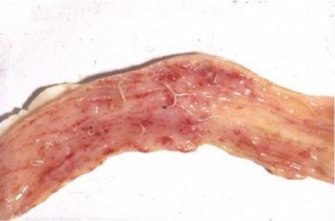Large-mouthed bowel worm is a large (20 mm) stout white worm. It is found in cool climate areas of southern Australia. The adult female lays around 5000 eggs per day. Under ideal environmental conditions, development from egg to third stage larvae (L3) takes around five weeks.
Further ecological information on worms and their control:
The large intestine.
Damage and inflammation of the gut resulting in diarrhoea (scouring).
The adult stages of large-mouthed bowel worm damage the lining of the bowel as they feed. They have large mouths and eat plugs of intestinal lining. Infected sheep or goats pass soft faeces and brown mucus containing flecks of blood.
In sheep with heavy infections of large-mouthed bowel worm the lining of the bowel is thickened and has longitudinal ridges, blood spots and small ulcers. Worms are clearly visible attached to the lining.

The only accurate way to diagnose worm infections before productivity losses have occurred is to conduct a WormTest (worm egg count). The results allow you to make the best choice of drench for the situation.
Visual signs only occur after significant production loss has already occurred. Also, these signs can occur with other parasites and diseases.
Large-mouthed bowel worm can be diagnosed during a post mortem, when nodules and the worms are seen.
There are many options to treat for this worm and your choice will depend on:
Your decision can be assisted by using the Drench Decision Guide, a simple tool that considers some of the points above.
You can also review the Drench pages on this site to find out specific information about drenches, including their drench active, drench group, length of protection, which worms they treat, dose rate, withholding period, export slaughter interval and manufacturer.
Note: only a few drench types are registered for use in goats.
The negative impact of this worm can also be reduced through browsing and grazing management strategies and by using one of the integrated worm control programs that have been developed for different regions across Australia.